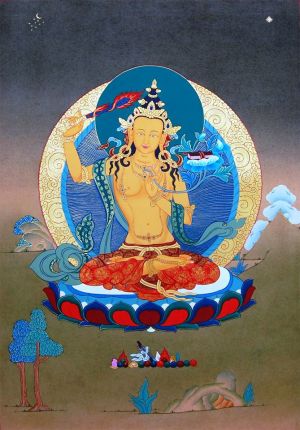Manjushri Bodhisattva
Manjushri the Bodhisattva of Wisdom, normally holds a sword in one hand, to cut off all delusion, and a Prajnaparamita Wisdom text in the other.
Prajnaparamita (Perfection of Wisdom) texts, are said to be the closest Buddhists ever got to putting truth (impossible task) into words.
Manjushri, as meditation experience, is a powerful image representing ever-present wisdom plus the sword of awareness to cut off all delusion.
Soko Morinaga Roshi once told the story of when his teacher (probably Goto Zuigan) ordered a new statue of Manjushri for his temple, and when the statue was delivered Zuigan asked the carver, ‘But where is the scabbard for the sword?’ This caused a bit of a panic because the carver’s family had been making Buddhist statues for over 300 years and they didn’t make mistakes. After a bit, Zuigan laughed and said, ‘Not to worry, Manjushri never puts away his sword anyway!’
Mantra of Manjushri Bodhisattva is ~ Om a ra pa cha na dhi [deee]. A good balance to Kuan Yin mantra ~ Kuan shih yin p’u-sa
Chinese, Wen Shu Shi Li / Wenshu; Sanskrit, Manjushri; Tibetan, Jam-dpal / Jamyang; Japanese, Monju; and Mongol, Manchushri.
And the Lord [[[Buddha]]] said again to Manjushri, the Crown Prince: On what grounds do you wish to fully know the utmost, right and perfect enlightenment?
Manjushri: If I had set out for enlightenment, then I would wish to fully know it. But I do not strive after enlightenment, because enlightenment is just the same thing as this Manjushri, the Crown Prince.
The Lord: You expound well, Manjushri, these very deep stations. That is because you have performed your duties under the Jinas of the past, and have coursed for a long time in the holy life which is devoid of a basis. (219)
Manjushri: If I were one who courses in the baseless, that would be equivalent to my having taken hold of a dharma.
The Lord: Do you see this my assembled company of accomplished Disciples?
Manjushri: I do, O Lord.
The Lord: How do you see it?
Manjushri: In such a way that I see no ordinary people, no learners, and no adepts. I do not see, and I also do not not see. But I see in such a way that I see neither many nor few, neither those who are disciplined nor those who are undisciplined. (220)…
.. Saradvatiputra: “Buddha,” Manjushri, of what is that a synonym?
Manjushri: Of what then is the term “self” a synonym?
Saradvatiputra: It is a synonym of nonproduction.
Manjushri: So it is, Rev. Saradvatiputra. The word “self” denotes the same thing which the word “Buddha” denotes. What is here called “the Buddha” is synonymous with “the trackless” (apada; also: wordless). Because it cannot easily be intimated by words (vak). It is not easy to define speech (vak), how much more so the Buddha! You want to know, Rev. Saradvatiputra, how one can describe the Buddha. (222) He is the one who is not in full possession of enlightenment, who has not been produced, who will not be stopped, who is not endowed with any dharma, of whom there is not track, who is undifferentiated, and just equivalent to the trackless. Those who seek for the Tathagata should seek for the self. For “self” and “Buddha” are synonymous. Just as the self does absolutely not exist, and cannot be apprehended, so also the Buddha. As the self cannot be expressed by any dharma, so also the Buddha. One speaks of a Buddha where definitions fail. As it is not easy to understand what the word “self” means, so it is (223) also not easy to understand what the word “Buddha” means.
Source
https://buddhismnow.com/2010/03/25/manjushri-bodhisattva/ [[Category:Buddhist Terms
